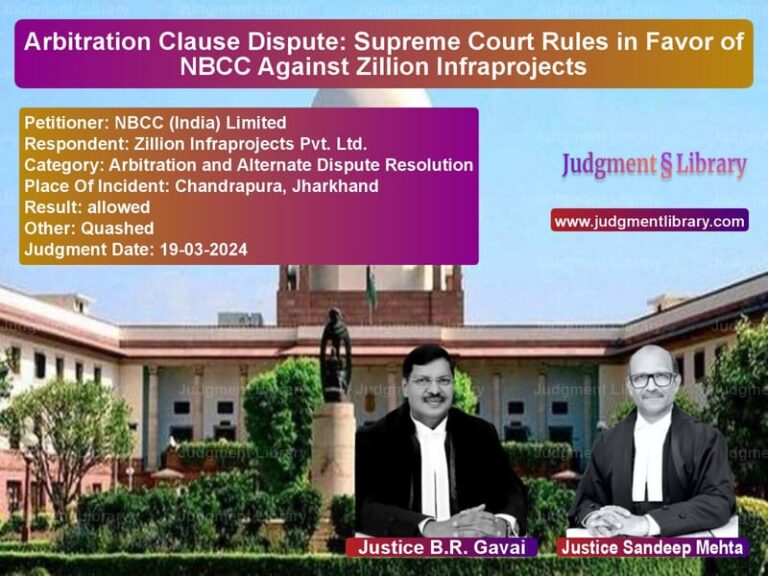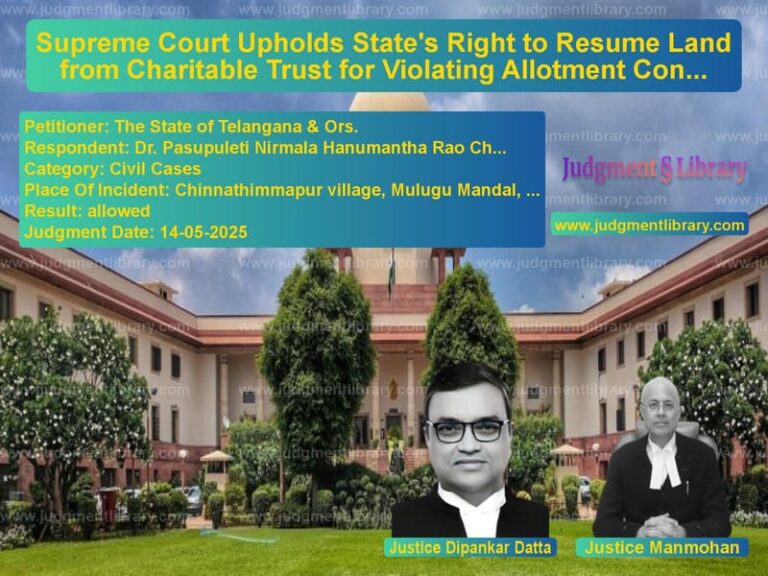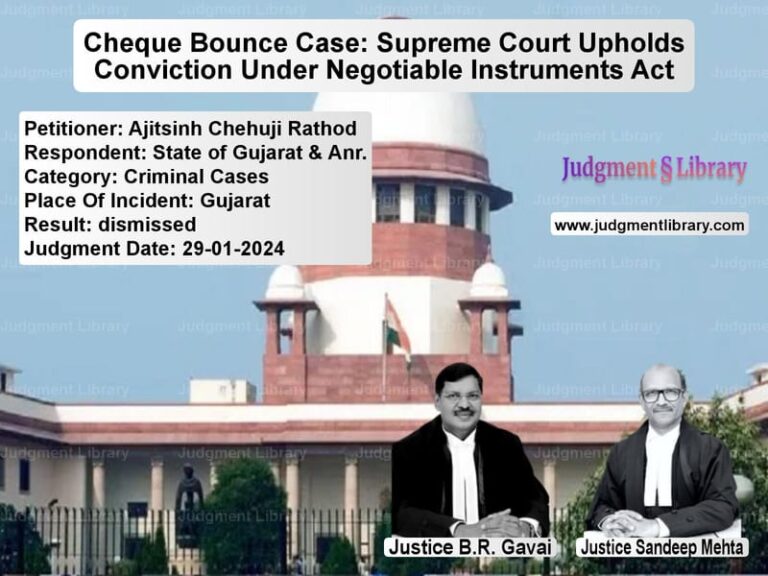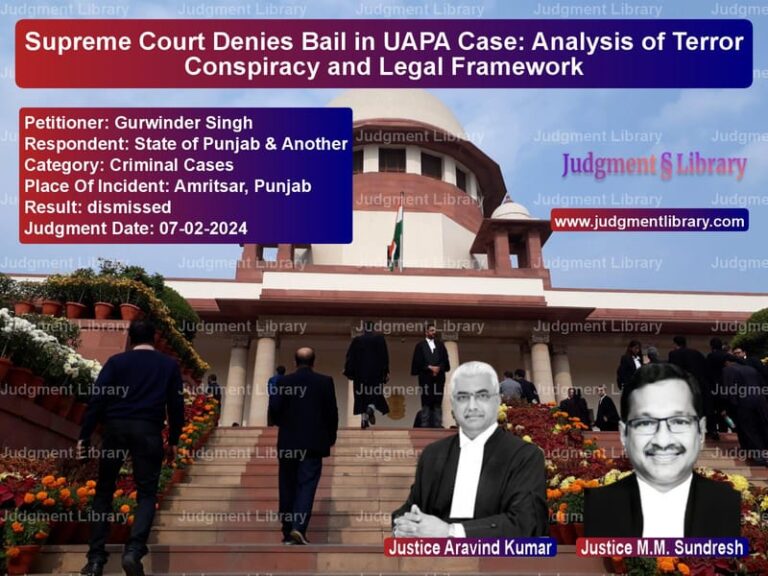Right to Private Defence and Legal Precedents: A Detailed Analysis of the Jangir Singh Case
The case of Jangir Singh versus The State of Punjab is an important criminal law case that revolves around the right to private defence, the exercise of self-defence, and the implications of causing disproportionate harm while defending oneself. The judgment, delivered by Justices N.V. Ramana and Mohan M. Shantanagoudar, addresses critical issues in criminal jurisprudence, particularly under Section 302 of the Indian Penal Code (IPC) and the Arms Act. The case involved the fatal shooting of Jaswant Singh by Jangir Singh, a fellow Punjab Home Guard volunteer, following an altercation regarding a loan repayment. The case is significant for its analysis of the right to private defence, the evidence presented, and the judicial interpretation of exceptions under Section 300 of the IPC.
Case Background
The incident that led to the death of Jaswant Singh occurred on June 5, 1991, around 7:30 PM, when Jangir Singh, the appellant, shot and killed Jaswant Singh. Both the appellant and the deceased were serving as Punjab Home Guard volunteers. The altercation between the two began when Jaswant Singh demanded Rs. 100, which he had previously lent to the appellant. This demand for repayment in front of their colleagues caused embarrassment to Jangir Singh, leading to an argument that lasted for about 15 minutes. The situation escalated, and in a fit of rage, Jangir Singh fired at Jaswant Singh with a Self-Loading Rifle of Bore 303, resulting in the latter’s death.
The Sessions Judge at Faridkot had acquitted Jangir Singh, concluding that the shooting was done in exercise of his right to private defence. However, the High Court reversed this judgment and convicted him under Section 302 of the IPC, holding that the right to private defence was not substantiated. This decision was challenged by Jangir Singh in the Supreme Court, which had to determine whether the appellant’s actions fell within the scope of self-defence and whether the High Court’s decision was justified.
Key Legal Issues
The central legal issues in this case were:
- Whether the appellant’s actions could be justified as an exercise of his right to private defence under the Indian Penal Code.
- Whether the High Court’s conviction of the appellant under Section 302 of the IPC was justified, or whether the case fell under Section 304 Part I due to the excessive harm caused by the appellant.
- Whether the evidence presented was sufficient to substantiate the High Court’s findings and whether the Sessions Court’s acquittal was correct.
Arguments Presented
Appellant’s Argument:
The appellant, represented by his counsel, contended that the trial court’s acquittal was correct, as the shooting was a legitimate exercise of his right to private defence. He argued that:
- The deceased, in an enraged state, aimed a rifle at the appellant during their altercation, creating an imminent threat to the appellant’s life.
- The appellant fired the gun in a spontaneous reaction to this threat, without premeditation or malice.
- The appellant had no intention to kill but acted out of fear for his life, which falls within the ambit of self-defence.
Respondent’s (State) Argument:
The State of Punjab, represented by its counsel, opposed the appeal and argued that:
- The appellant’s actions were not justifiable as self-defence. The shooting was not a proportionate response to the altercation.
- The appellant exceeded the limits of self-defence by using a firearm, particularly aiming at a vital part of the deceased’s body.
- The evidence presented by key witnesses, particularly PW-3 and PW-4, was sufficient to prove that the appellant’s actions were not in self-defence but were an act of intentional homicide.
The Supreme Court’s Decision
The Supreme Court thoroughly examined the facts of the case, the evidence, and the legal provisions under the IPC, particularly the right to private defence. After evaluating the testimonies and the circumstances surrounding the incident, the Court held that while the appellant’s claim of self-defence had merit, the manner in which he exercised that right exceeded the permissible limits.
Verbatim Judge’s Arguments:
“It is a settled law that the right to private defence cannot be claimed by the accused if disproportionate harm has been caused while defending himself or any other person. However, if the accused has not caused disproportionate harm, then the benefit of Exception II to Section 300 of IPC can be given to the accused.”
The Court further observed:
“In this case, the appellant acted in good faith, but the shooting was not in proportion to the threat posed by the deceased. The appellant could have avoided shooting at a vital part of the body. However, the firing was done with the perception of an imminent threat, and there was no premeditation.”
The Court noted that the incident arose from a heated altercation and that the appellant fired the gun after the deceased pointed a rifle at him. While the act of shooting was an excessive response, it was found that the appellant acted out of fear for his life. Therefore, the Court concluded that the appellant’s actions fell under Exception II to Section 300 of the IPC, which provides that culpable homicide is not considered murder if the act was done in good faith while exercising the right to private defence.
Modification of Conviction:
The Court, while acknowledging the appellant’s right to self-defence, ruled that the appellant had exceeded the scope of that right by causing disproportionate harm. The Court, therefore, modified the conviction from Section 302 (murder) to Section 304 Part I (culpable homicide not amounting to murder), as the appellant had acted without premeditation but had caused more harm than necessary in the heat of the moment.
“The offence committed by the appellant will fall under Section 304 Part I of the IPC, as the harm caused was excessive in relation to the threat posed by the deceased. The appellant is not guilty of murder but of culpable homicide.”
The Court cited several precedents, including the cases of Bhanwar Singh v. State of Madhya Pradesh and Darshan Singh v. State of Punjab, which established that when an accused exceeds the right to private defence, the appropriate conviction is under Section 304 Part I of the IPC.
Conclusion and Sentencing:
Given that the appellant had already undergone 10 years of actual imprisonment, the Court directed that the appellant be released, as this amount of time served was equivalent to the maximum sentence under Section 304 Part I of the IPC.
The Court concluded:
“The appeal stands disposed of, and the conviction is modified to Section 304 Part I of the IPC. The appellant shall be released forthwith if not required in any other case.”
The judgment reinforced the importance of the right to self-defence while also stressing the need for proportionality in such actions. The case highlights the delicate balance courts must maintain when determining whether an act of self-defence crosses into the realm of excessive force, thus resulting in culpable homicide.
Petitioner Name: Jangir Singh.Respondent Name: The State of Punjab.Judgment By: Justice N.V. Ramana, Justice Mohan M. Shantanagoudar.Place Of Incident: Punjab.Judgment Date: 31-10-2018.
Don’t miss out on the full details! Download the complete judgment in PDF format below and gain valuable insights instantly!
Download Judgment: Jangir Singh vs The State of Punjab Supreme Court of India Judgment Dated 31-10-2018.pdf
Direct Downlaod Judgment: Direct downlaod this Judgment
See all petitions in Bail and Anticipatory Bail
See all petitions in Fraud and Forgery
See all petitions in Murder Cases
See all petitions in Theft and Robbery Cases
See all petitions in Judgment by N.V. Ramana
See all petitions in Judgment by Mohan M. Shantanagoudar
See all petitions in allowed
See all petitions in supreme court of India judgments October 2018
See all petitions in 2018 judgments
See all posts in Criminal Cases Category
See all allowed petitions in Criminal Cases Category
See all Dismissed petitions in Criminal Cases Category
See all partially allowed petitions in Criminal Cases Category







